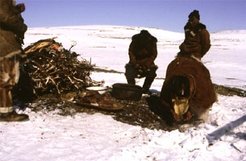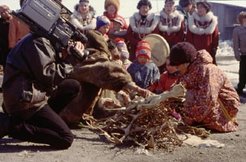Maintaining or reinventing a relation to 'Nature': religious practices and systems of representation in contemporary Chukchi society (Siberian Arctic)
This research focuses on the conception of and interaction with ‘nature’ in contemporary Chukchi society. I define ‘relation to nature’ as the symbolic relationship that the human community maintains with both its ‘natural’ (landscape, animals, etc.) and its ‘supernatural’ (spirits and other entities) environments.

One of the spheres most directly affected by Soviet policies has been the relation to ‘nature’. Collectivisation, sedentarization, the policy of educating nomadic children in boarding schools, and state-promoted atheism were aimed at effecting a radical shift in forms of interaction with ‘nature’ and at destroying the conceptions related to it. However, today’s situation regarding interaction with and conceptions of ‘nature’ shows not only change but, just as importantly, a subtle pattern of persistence and continuity over time.
There has been quite a long hiatus in research in Chukchi religious practices. The main sources of information date back to Bogoraz at the end of the 19th century, followed by Kuznetsova and Vdovin, in the Soviet era. Yet despite this lack of recent attention, the post-Soviet religious situation in Chukchi society is highly diverse and interesting.
- First, there are ‘pre-Soviet’ rituals which still exist in part today. Herding rituals, for example, can still be observed in a form close to those described a century ago by Waldemar Bogoraz, the author of the most complete monograph on Chukchis. This has been possible in areas where herding still remains alive and in places that were located far from the central Soviet power.
- Among sea-mammal hunters and in urban areas, on the other hand, rituals no longer exist in their ‘traditional’ forms. Instead, one can observe ‘Soviet-inspired’ rituals or attempts at reviving ‘pre-Soviet’ rituals.
- In this emerging ‘revivalism’, we sometimes find the burgeoning influence of the New Age and neo-shamanist movements. This is in part due to the Russian translation of Michael Harner’s books, in which middle-age Chukchis are able to find information to add to their inherited knowledge. Harner is a trained anthropologist who left academia. He is very active in Russia and is involved in funding research in Moscow on shamanism. ‘Western shamanism’ was inspired by ‘exotic’ indigenous cultures, but has created its own ‘global’ model. This model, called ‘core shamanism’ by Harner and his followers, is now returning to the places it came from, but in another form.
- Lastly, the Chukchis are now a target of active proselytism by Protestant denominations. Attempts by missionaries in the 19th century to convert the Chukchis to Christianity were largely unsuccessful. But Protestant movements, such as the Seventh-Day Adventists and the Pentecostalists, have managed to gain a growing influence over the last 10 years in Chukotka. They are now beginning to reach even those reindeer-herding regions where ‘traditional’ rituals are still performed.
Thus, within this complex context, I plan to study how all these elements interpenetrate and influence one another in Chukchi representations of ‘nature’ today. This study brings together the anthropology of religion and the anthropology of nature. I will pay particular attention to studies on Siberian shamanism and on neo-shamanism, but not only. I particularly subscribe to the approach of Philippe Descola (1986), who considers that ‘it is illusory and useless to separate technical determinations from mental determinations’. As fieldwork revealed to me, for Chukchis, the ‘pragmatic’ is closely connected to the ‘symbolic’. Indeed ‘nature’ and ‘supernatural’ entities are conceived as belonging to one continuum, which includes also human beings.

In this research, I will reveal attitudes towards this religious diversity according to the gender of the subjects concerned, their generation, their knowledge of Chukchi language and the environment from which they come. I will pay attention to the interactions between different religious influences and to their circulation in different areas (city, herders’ and hunters’ villages, tundra). I will explore this from diachronic as well as synchronic perspectives.
This will question the issue of form and content of rituals, present at different levels from the ‘traditional’ rituals to the Protestant movements. For instance, today ‘pre-soviet’ rituals still persist in their form, but do they likewise persist in content? ‘Traditionally’, herders and hunters have different ritual cycles, but do these distinctions reflect different representations of their relationship to ‘nature’? Atheist Soviet policy attempted to create rituals ‘national in form, but socialist in content’. Did they succeed in their attempt? I mentioned that some middle-age Chukchis look to Harner’s books for content for their rituals. Does this new content, in turn, influence the form? And lastly, Pentecostalists and Adventists radically condemn the form of all Chukchi ritual practices. But can they replace their content?
This research is based on 31 months of fieldwork, undertaken both in rural and urban areas of Chukotka, including 6 months in tundra encampments. Further fieldwork is planned in herding areas and sea-mammal hunting areas as well as urban areas. The work will be complemented by archival research in Saint-Petersburg.

